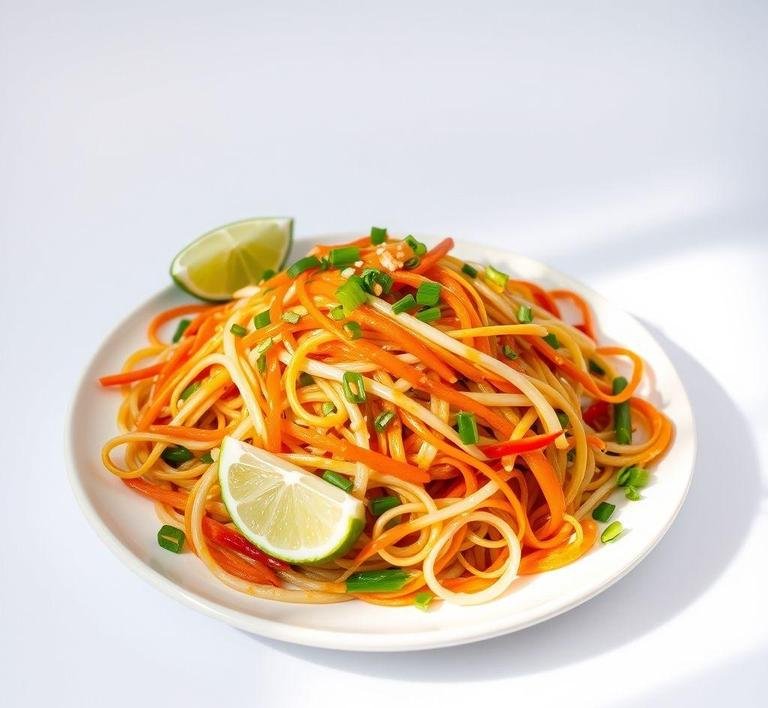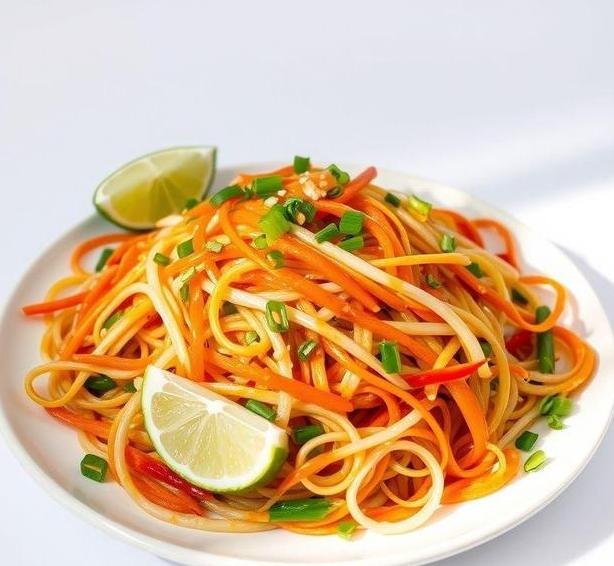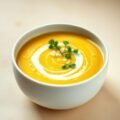Mary Berry’s Vegetable Pad Thai is her delightful take on the classic Thai street food, Pad Thai, which is known for its vibrant blend of sweet, savory, sour, and spicy flavors. This version stays true to her elegant, practical approach to cooking-fresh, wholesome ingredients treated simply, yet skillfully.
Vegetable Pad Thai, at its heart, is a stir-fried noodle dish. It’s usually made with rice noodles, a colorful array of crisp vegetables, and a rich, tangy sauce built from tamarind, lime, soy sauce, and sometimes a touch of sugar and chili for that sweet-heat balance. Mary Berry’s version embraces a medley of crunchy vegetables-think carrots, bell peppers, spring onions, and bean sprouts-tossed in a flavorful sauce and topped with peanuts and fresh herbs. It’s quick to cook, satisfying, and entirely vegetarian-though you could easily adapt it to be vegan or include protein like tofu, prawns, or chicken.
What makes her recipe shine is the balance-nothing is too heavy, too salty, or too spicy. It’s approachable, elegant, and perfect for both weeknight dinners and casual entertaining.
Mary Berry’s Vegetable Pad Thai Recipe
Ingredients Needed

Let’s break this down by type so you can gather everything you need efficiently. Mary Berry’s ingredient list is carefully curated-each element has a role to play, contributing to the flavor profile, texture, or visual appeal of the dish.
For The Pad Thai
- 200g (7 oz) flat rice noodles – ideally the medium-width kind. These soften up beautifully and absorb the sauce like a dream.
- 1 tablespoon sunflower oil – neutral and perfect for high-heat cooking.
- 2 carrots, peeled and julienned – these add crunch and sweetness.
- 1 red bell pepper, deseeded and thinly sliced – for vibrant color and a hint of sweetness.
- 100g (3.5 oz) mangetout or sugar snap peas, halved lengthways – for a fresh, green crunch.
- 4 spring onions, sliced on the diagonal – they add a subtle oniony bite and a lovely freshness.
- 100g (3.5 oz) bean sprouts – essential for that classic Pad Thai texture.
- 2 eggs, lightly beaten – scrambled into the noodles for protein and richness.
- A small handful of fresh coriander leaves, roughly chopped – to sprinkle on top.
- 50g (1.75 oz) roasted salted peanuts, roughly chopped – a must-have for crunch and contrast.
- Lime wedges, to serve – adds zing right before serving.
For The Sauce
- 2 tablespoons soy sauce – use light soy for flavor without too much salt.
- 1 tablespoon sweet chilli sauce – for gentle heat and sweetness.
- 1 tablespoon lime juice – freshly squeezed for brightness.
- 1 teaspoon soft brown sugar – balances the acidity and saltiness.
Equipment Needed
While this is a relatively simple dish to make, having the right equipment can make a big difference in terms of ease and efficiency:
- Large mixing bowl – for soaking the rice noodles.
- Wok or large non-stick frying pan – crucial for high-heat stir-frying. A wok gives you plenty of space to toss everything together.
- Sharp knife and chopping board – precision slicing makes a big difference in texture and presentation.
- Small bowl or jug – to mix your sauce ingredients.
- Wooden spoon or silicone spatula – for stirring without damaging your pan.
- Colander or sieve – to drain the noodles.
- Tongs – for gently tossing the noodles with the vegetables.
Instructions To Make Mary Berry’s Vegetable Pad Thai
Now the fun part-bringing everything together. Pad Thai is a dish that comes together quickly, so prep everything before you start cooking.
Step 1: Prepare The Noodles
Start by soaking your rice noodles in hot (not boiling) water for about 10-15 minutes, or until they’re just tender but still have a bite. Drain them well and toss with a little oil to prevent sticking.
Step 2: Make The Sauce
In a small bowl, whisk together the soy sauce, sweet chilli sauce, lime juice, and brown sugar. This simple sauce is the soul of your Pad Thai-perfectly balanced and packed with flavor.
Step 3: Stir-fry The Vegetables
Heat the sunflower oil in your wok over medium-high heat. Add the carrots, bell peppers, and mangetout. Stir-fry for about 3-4 minutes, until they start to soften but still have crunch. Add the spring onions and bean sprouts and cook for another minute.
Step 4: Add The Eggs
Push the vegetables to one side of the pan. Pour the beaten eggs into the other side. Scramble them gently until just set, then mix them through the vegetables.
Step 5: Combine Noodles And Sauce
Add the soaked noodles to the wok, followed by the sauce. Toss everything together so that the sauce coats the noodles and vegetables evenly. Stir-fry for another 2-3 minutes until everything is hot and well combined.
Step 6: Garnish And Serve
Transfer to serving plates, scatter over the chopped peanuts and coriander, and serve with lime wedges on the side. A final squeeze of lime juice brings everything to life!
Tips And Tricks
Here’s where we get into the chef’s secrets-the little things that elevate the dish:
- Don’t over-soak your noodles. Keep an eye on them; you want them soft but still slightly chewy, or they’ll turn mushy in the pan.
- Prep everything before you begin cooking. This dish cooks fast, so having all your veggies sliced and sauce mixed ahead of time is essential.
- Use a very hot pan. Wok cooking is all about high heat and quick cooking. Make sure your pan is preheated so the veggies sizzle when they hit it.
- Try tofu or prawns for variation. For more protein, add pan-fried tofu or cooked prawns. Fry them first and set aside, then stir them back in with the noodles.
- Balance the flavors to your liking. Mary Berry’s sauce is mild and balanced. If you prefer more kick, add a dash of sriracha or extra lime juice at the end.
Mary Berry’s Vegetable Pad Thai is a glorious celebration of freshness, flavor, and ease. It takes a beloved Thai street food and makes it entirely accessible for the home cook-no obscure ingredients or complicated techniques, just simple steps leading to a stunning result.
Whether you’re cooking for yourself on a busy weeknight or entertaining friends with an exotic yet familiar dish, this Vegetable Pad Thai delivers every time. It’s a dish that’s as much about the vibrant vegetables and zingy sauce as it is about the joy of cooking something satisfying, healthy, and utterly delicious.
Easy Recipe Variations For Mary Berry’s Vegetable Pad Thai

Mary Berry’s Vegetable Pad Thai is a brilliant celebration of fresh ingredients, zesty tang, and just the right amount of crunch. But here’s the beauty of it: while her recipe is wonderfully balanced, it’s also incredibly adaptable. Whether you’re catering to different dietary needs or simply looking to switch things up, there’s a world of possibilities. Here are some of the most delightful variations you can try:
1. Protein Boosts
- Tofu or Tempeh: For those looking to keep things plant-based, crispy tofu or marinated tempeh adds heft and protein. Press and pan-fry tofu until golden, then toss it in just before serving for that lovely texture contrast.
- Eggs: While Mary’s version might already include egg ribbons, you can amplify it with a Thai-style omelet sliced into strips or stir the eggs directly into the wok to form soft curds.
- Chicken or Shrimp: If you’re not vegetarian, thinly sliced chicken breast or peeled prawns sautéed in garlic and ginger offer a lovely meaty balance to the veg-forward dish. Add them early in the stir-fry so they cook through properly.
2. Veggie Swaps & Additions
- Seasonal Vegetables: Mary’s classic selection may include bean sprouts, carrots, and peppers, but you can experiment with what’s in season. Think tenderstem broccoli, snap peas, edamame, or baby corn.
- Leafy Greens: A handful of spinach or pak choi stirred in at the last moment wilts beautifully and melds with the sauce.
- Mushrooms: Shiitake or oyster mushrooms add a delightful umami dimension. Slice and sauté them until golden for maximum flavor.
3. Sauce Tweaks
- Nut Butters: A tablespoon of peanut or almond butter added to the sauce gives it a creamy, indulgent twist without overpowering the traditional flavors.
- Spice Levels: Amp up the heat with extra chili flakes, a dash of Sriracha, or fresh bird’s eye chilies if you crave a fiery kick.
- Vegan Version: Swap out fish sauce for tamari or soy sauce with a splash of rice vinegar and a touch of brown sugar for that salty-sour balance.
4. Noodle Alternatives
- Zoodles or Spiralized Veggies: For a lighter take, spiralized courgette (zucchini), carrot, or even sweet potato noodles can be a fresh alternative.
- Brown Rice Noodles or Whole Wheat: A heartier, more fibrous option that keeps the integrity of traditional Pad Thai but adds a rustic touch.
Storing Leftovers
So, you’ve made a generous batch of Mary Berry’s Vegetable Pad Thai, and there’s some left in the wok-great news! Properly storing leftovers not only helps reduce food waste but also makes for a delicious next-day meal. Here’s how to keep it fresh and fabulous:
Refrigeration Tips
- Cool Before Storing: Allow the dish to come to room temperature before refrigerating to avoid condensation, which can make the noodles soggy.
- Use Airtight Containers: Transfer the Pad Thai into a tightly sealed container to lock in flavor and prevent it from absorbing fridge odors.
- Shelf Life: Stored properly, the leftovers will keep well in the fridge for up to 3 days.
Freezing? Not Recommended
While many stir-fry dishes freeze well, Pad Thai can be a bit tricky. The noodles tend to become mushy upon reheating from frozen, and the vegetables lose their texture. If you must freeze it, consider freezing the sauce separately and preparing fresh noodles and vegetables when you’re ready to enjoy it again.
Reheating Tips
- Stovetop Best: A quick toss in a hot pan with a splash of water or extra sauce helps revive the noodles beautifully.
- Microwave Method: Use a microwave-safe container, cover it loosely, and heat in short intervals (30-60 seconds), stirring in between to avoid overheating any one section.
Pro tip: A squeeze of fresh lime juice and a sprinkle of chopped peanuts or coriander just before serving can bring the leftovers back to life.
What To Eat With Mary Berry’s Vegetable Pad Thai?
While Vegetable Pad Thai is a showstopper all on its own, pairing it with complementary sides and drinks can elevate the entire dining experience. Whether you’re planning a Thai-themed dinner night or just want to make the meal more satisfying, here are some great ideas to round out the menu:
1. Appetizers & Starters
- Spring Rolls: Crisp vegetable or shrimp spring rolls with a sweet chili dipping sauce are a classic pairing. Their crunch contrasts wonderfully with the soft noodles.
- Thai Cucumber Salad (Som Tum): Refreshing, tangy, and lightly spiced, this salad made with julienned cucumber, carrots, and a lime-based dressing balances the richness of the Pad Thai.
- Tom Yum Soup: A hot and sour soup with mushrooms, lemongrass, and a hint of chili offers a wonderful contrast to the stir-fried noodles.
2. Sides To Serve Alongside
- Sticky Rice or Jasmine Rice: A scoop of fragrant rice can help mellow the heat and soak up any extra sauce.
- Satay Skewers: Whether it’s tofu or chicken, grilled skewers slathered in peanut sauce bring extra protein and a smoky flavor to the table.
- Asian Slaw: A crunchy cabbage salad dressed with sesame oil, rice vinegar, and lime juice offers a cooling bite between forkfuls of Pad Thai.
3. Drinks To Sip
- Thai Iced Tea: This creamy, sweet black tea with condensed milk is a luxurious treat that pairs beautifully with spicy dishes.
- Sparkling Water with Lime: Crisp and clean, it refreshes the palate between bites.
- Coconut Water: Naturally sweet and hydrating, it complements the tropical undertones of Thai cuisine.
Conclusion
Mary Berry’s Vegetable Pad Thai is not just a recipe-it’s a canvas for culinary creativity. With its vibrant flavors, textural contrasts, and adaptability, it’s a dish that invites personalization. Whether you stick to the classic or explore variations with tofu, spice, and alternative noodles, there’s joy to be found in every stir-fried bite.
Storing leftovers smartly ensures that your hard work doesn’t go to waste, and pairing the Pad Thai with thoughtful sides and drinks can turn a simple weeknight dinner into a full-on Thai-inspired feast. So go ahead-tweak, taste, experiment, and enjoy. In true Mary Berry fashion, let every meal be a delicious adventure.
FAQs
What Vegetables Are Used In Mary Berry’s Vegetable Pad Thai Recipe?
Mary Berry’s vegetable pad thai recipe features a variety of fresh vegetables, including bell peppers, carrots, courgettes (zucchini), and spring onions. These vegetables are julienned and stir-fried to provide a crunchy texture that complements the soft rice noodles, giving the dish a balanced and vibrant flavor profile.
Can I Substitute Any Ingredients In Mary Berry’s Vegetable Pad Thai?
Yes, you can modify the recipe to suit your preferences or dietary needs. For example, you can replace the tofu with tempeh for a firmer texture, or use gluten-free noodles if you’re avoiding gluten. You can also adjust the vegetables based on what’s available in your area, such as adding broccoli, mushrooms, or snap peas in place of other vegetables.
How Do I Make The Sauce For Mary Berry’s Vegetable Pad Thai?
The sauce for Mary Berry’s vegetable pad thai is made from a combination of tamarind paste, fish sauce, and a touch of sugar to create a balanced sweet, salty, and tangy flavor. You can adjust the amounts based on your taste preferences, or use soy sauce as a vegetarian alternative to fish sauce. The sauce is then poured over the stir-fried vegetables and noodles to infuse them with flavor.


